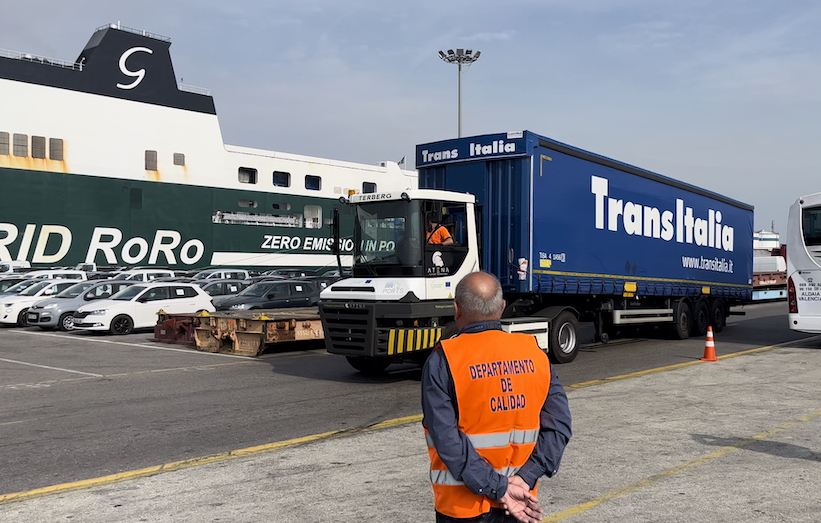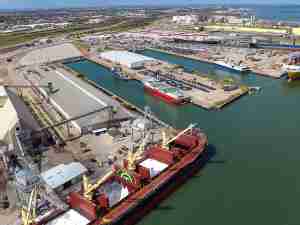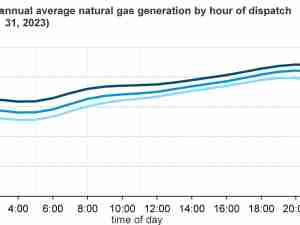The Port of Valencia is today the first port in the world to use a 4x4 truck tractor unit powered by green hydrogen to move containers within its terminals. This is yet another milestone in the roadmap that the Port Authority of Valencia (PAV) is working to achieve zero emissions targets by 2030. A historic event for the entire port community of Valencia and the port system worldwide.
This morning the 4x4 terminal tractor, which disembarked last week in the port area, carried out the first operational test at Valencia Terminal Europa (VALTE) of the Grimaldi Group under the supervision of the team of inspectors of the European H2PORTS project. Specifically, the tractor loaded with green hydrogen demonstrated its autonomy, reliability and power at the VALTE facilities. It first performed an unladen test, with just the tractor head, and then hitched up a truck trailer and drove around the terminal. The test was observed by more than 40 technicians, supervisors and representatives of the companies participating in the project, who saw how the only residue from the hydrogen combustion water droplets was.
After the tests, the president of the PAV, Joan Calabuig, stressed that "it is very important for the objective of the total decarbonisation of Valenciaport in 2030 to see that the Port of Valencia is at the forefront in Europe and at the forefront in the world when it comes to introducing the first 4X4 truck which is already operating for the first time in Valencia with green hydrogen". Calabuig confirmed this first operation in situ, "an exceptional event which fills us with pride and which shows for the first time in the world in the Port of Valencia this technology which completely eliminates pollution".

Along these lines, the head of Valenciaport reaffirmed "the commitment we are making to these technologies" and remarked that "we are only at the beginning of our commitment to introduce hydrogen as a central element of mobility. It is the beginning of a path that will bring about an extraordinary transformation in the field of mobility".
For his part, Domenico Ferraiuolo, CEO of Valencia Terminal Europa (VALTE) and Grimaldi Ports, indicated that "advancing in the decarbonisation of ships and land-based terminal machinery with zero emissions is a very important objective for Valencia and for the Grimaldi Group. Both institutions are very committed to decarbonisation in maritime transport. Today's event is an example of this". Antonio Crespo, director of VALTE, has also stated that "it has been a very long job, almost two years with this project, with many people involved. To see it working today, and with excellent quality and safety parameters, is something to be very proud of".
Lionel Boillot, Project Officer Clean Hydrogen JU of the European Commission, stressed that "this is the first time that this machinery has worked with spectacular results to help move containers within the Port of Valencia without emissions. This tractor unit uses green hydrogen which, through a fuel cell and batteries, transforms the hydrogen into electricity to move this equipment which is going to operate containers inside a terminal". And he stressed that "it is the first time in Europe and in the world that we see this technology applied to port operations. It is a project that combines contributions from European funds, companies and research centres. These are solutions for the future that are already working in the Port of Valencia".
In this respect, Antonio Torregrosa, director of the Valenciaport Foundation, indicated that "these first tests are going very well. Once again, we have managed to be the first port in Europe to test a cutting-edge technology at the service of improving operations and the sustainability of our actions. One of the elements of competitiveness of this port has been innovation. For this reason, for some time now we have been testing all kinds of technologies that have made this port a reference port in the world in terms of sustainability, digitalisation and efficiency".
This first operation has been supervised by the technical team of the entities ATENA, VALTE, the Grimaldi Group, the National Hydrogen Centre, Carburos Metálicos and the Valenciaport Foundation as coordinator of this initiative. The 4x4 tractor unit is the first hydrogen-powered unit in the world and has been developed by ATENA, a research and technology centre made up of universities, research institutes and private companies based mainly in the Italian region of Campania.
It should be noted that the Port of Valencia has had a hydrogen supply station since January, within the framework of the H2PORTS programme. It is the only installation capable of supplying the needs of the terminals through the mobile hydrogen generator and the fixed tank which stores this fuel.
This hydrogen supply station (HRS) includes a fixed part dedicated to the reception, storage and compression of hydrogen up to delivery pressure, on which the test was carried out today, and a mobile part that stores the compressed hydrogen and has a dispenser for refuelling the port machinery.
This tractor is the first of two prototypes that will be tested for two years at the Valencian site. The second, which will arrive in the coming weeks, is a hydrogen ReachStacker (container stacker) which Hyster is developing within the framework of the European H2PORTS project and which will be tested at the MSC terminal. It should be noted that staff from the Valenciaport Foundation, the MSCTV terminal and representatives of the Valencian dockers visited the Hyster-Yale Group facilities in Weeze (Germany) in February to familiarise themselves with its operation.
H2PORTS
The European project "H2PORTS - Implementing Fuel Cells and Hydrogen Technologies in Ports" coordinated by the Valenciaport Foundation, in close collaboration with the Port Authority of Valencia, and financed by the Clean Hydrogen Partnership programme, has as its main objective to test and validate hydrogen technologies on port machinery that allow for applicable and real solutions without affecting the performance and safety of port operations and producing zero local emissions.
The H2Ports project involves a total investment of 4 million euros and, in addition to the Valenciaport Foundation and the Port Authority of Valencia, the National Hydrogen Centre, and the private companies MSC Terminal Valencia, Grimaldi Group, Hyster-Yale, Atena Distretto Alta Tecnologia Energia Ambiente, Carburos Metálicos, Ballard Power Systems Europe and Enagás.
Thanks to this initiative, the Port of Valencia is the first port in Europe to incorporate hydrogen technologies to reduce the environmental impact of its operations.










